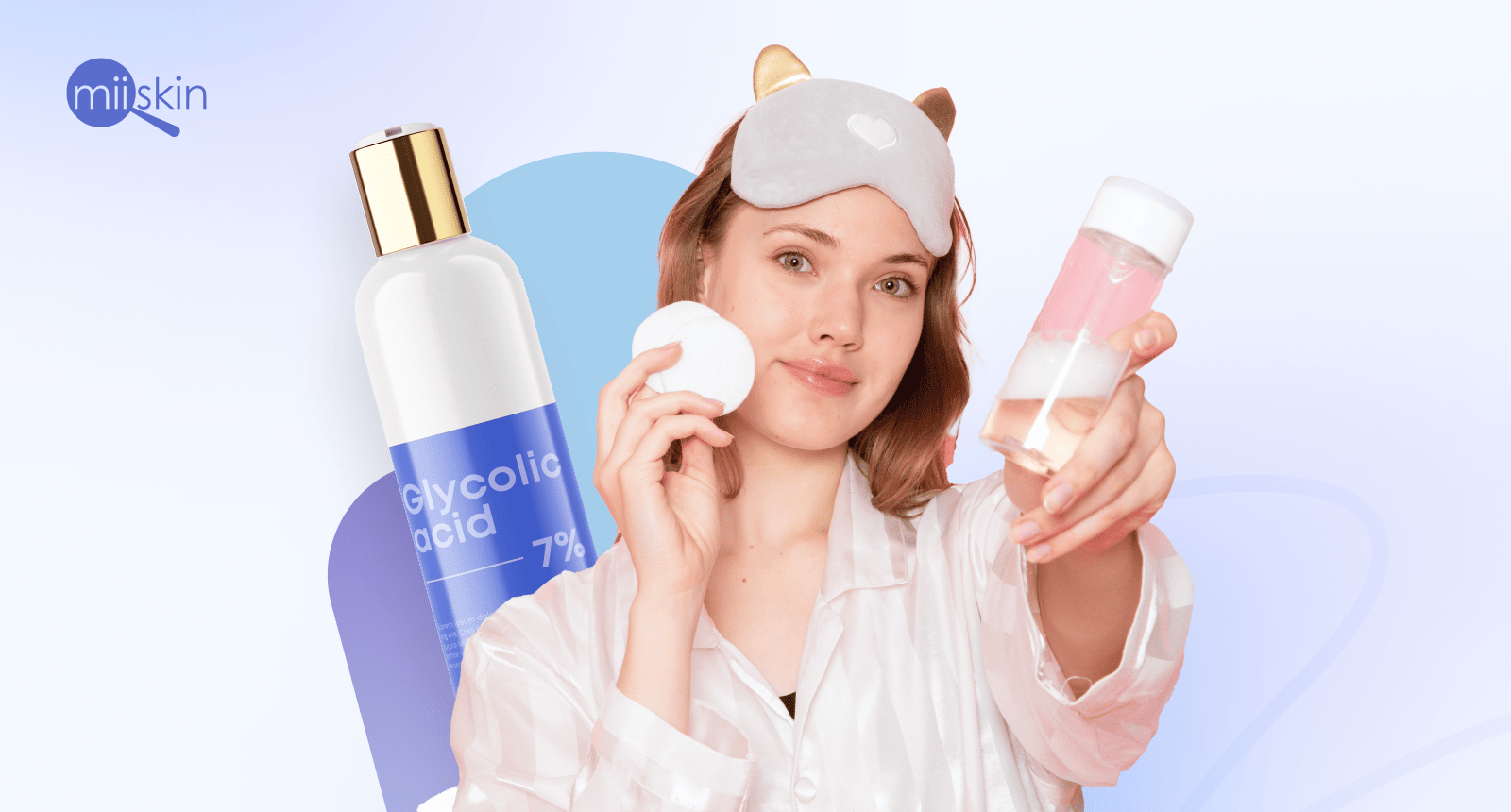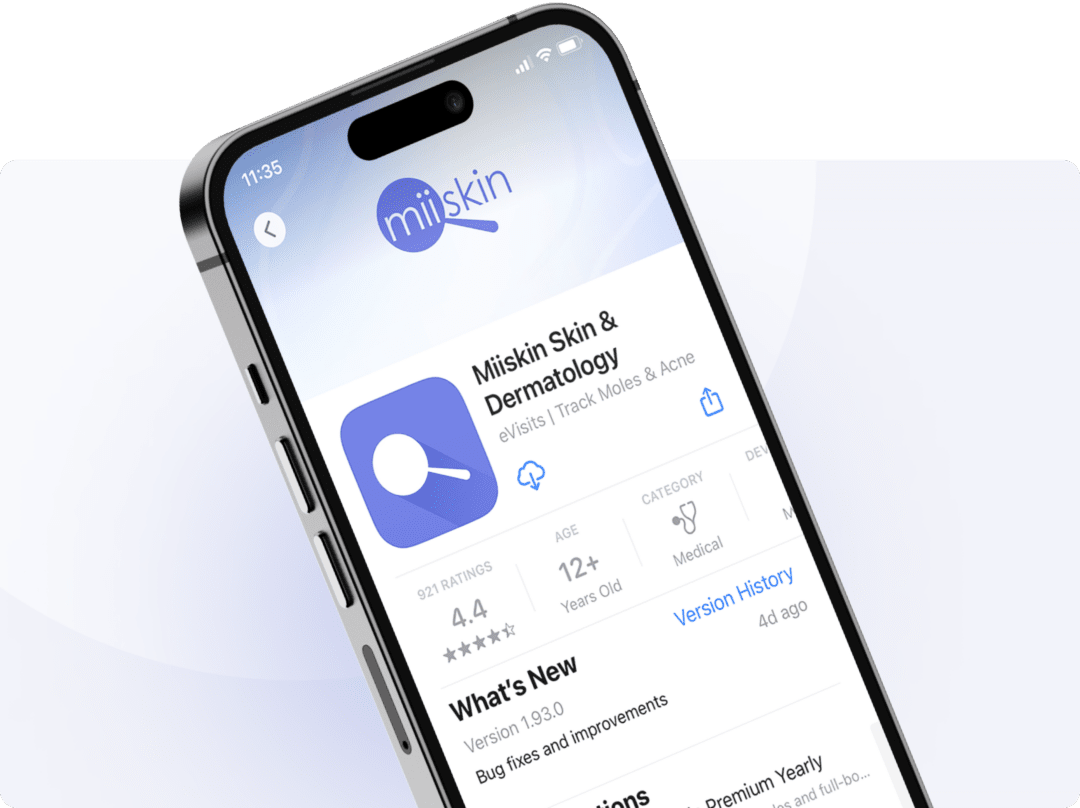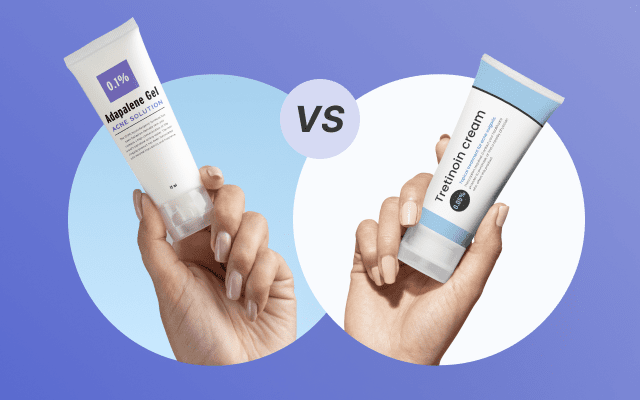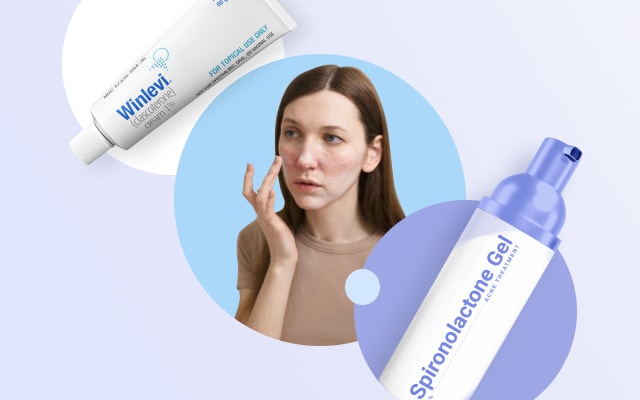How to get a glycolic acid for acne or anti-aging?
Dr. Aditi Shende, dermatologist, talks about the many benefits of glycolic acid, how to use it, and how you can you get it.
Table of Content:
What is glycolic acid? | How does it work? | What is it used for? | How to get a prescription? | How to use it? | Side-effects | Is it safe during pregnancy? | What can you combine it with? | Use for armpits | Use for scalp | Use for feet
Our commitment to producing high-quality content:
The information presented in this article is based on scientific research and the professional advice of our Content Medical Reviewers, who are experts in the field of Dermatology. How we write our content →
Glycolic acid (GA) is widely used in dermatology due to the many benefits it brings to the skin, but what is it exactly? How does it work? How can you safely incorporate it into your skin care routine? We talked with Dr. Aditi Shende, board-certified dermatologist and she shared some insights on this valuable skincare ingredient that can be used for acne, hyperpigmentation and anti-aging.
What is glycolic acid?
Glycolic acid is one of the most popular and widely investigated Alpha Hydroxy Acids (AHA) due its versatility for skincare.
Glycolic acid is considered the gold standard for chemical exfoliation because it has the smallest molecules of the AHA group, so it can penetrate skin more easily, making it very effective for improving dull skin, hyperpigmentation, acne, and wrinkles1.
Do you need a prescription for glycolic acid?
Many glycolic acid products with a low concentration are available over the counter. However, if OTC products have not given you the results you expect, you probably need prescription-strength products.
How to get an online prescription for glycolic acid?
To get a prescription for glycolic and salicylic acid you can have a photo-consultation with a dermatology provider for only $59. You will get an answer in 1-2 working days together with your prescription, if medically adequate for you.
Request a prescription
How does glycolic acid work?
According to Dr. Shende, glycolic acid works primarily by exfoliating and renewing the skin; here is how it does it.
Exfoliates the skin
Since Glycolic acid has a small molecular size, it can penetrate the skin effectively. When it is applied topically, it loosens and breaks down the bonds between dead skin cells on the surface of the skin. This action makes it easier for these dead cells to be sloughed off, revealing fresher, brighter skin underneath2.
Promotes increased cell turnover
By promoting the shedding of dead skin cells, glycolic acid accelerates the skin’s natural cell turnover process; this means that new skin cells are produced quicker contributing to smoother and more even-toned skin3.
Stimulates collagen production
Glycolic acid can also stimulate the production of collagen in the dermal layer of the skin4. Collagen is a protein that provides structural support to the skin, helping it maintain firmness and elasticity5. Glycolic acid’s collagen-stimulating effect can help improve the skin’s texture and reduce the appearance of fine lines and wrinkles.
Improves in skin texture
Regular use of glycolic acid can lead to an improvement in skin texture. It can help reduce the appearance of fine lines, minimize the size of pores, and even out skin tone6.
Fosters the enhanced absorption of other skincare products
Dr. Shende explained that exfoliating your skin with glycolic acid can improve the absorption of other skincare products, allowing them to penetrate more deeply into the skin and potentially make them more effective.

What is glycolic acid used for?
Acne treatment
Glycolic acid can be effective in treating acne and preventing breakouts. It can help unclog pores, reduce the buildup of oil and debris, and fade acne scars over time7.
Hyperpigmentation
Glycolic acid is also one of the ingredients used to address hyperpigmentation concerns, such as dark spots, melasma, and post-inflammatory hyperpigmentation. It can help lighten and even out skin tone.
Glycolic acid peels are also a popular treatment for hyperpigmentation. These treatments should always be performed by a dermatologist to prevent skin damage.
Anti-aging
The regular use of glycolic acid promotes increased cell turnover and stimulates collagen production, which can lead to firmer, more youthful-looking skin8 9 .
Step by step guide: How to use glycolic acid?
Dr. Shende says you should always follow the instructions given by your dermatologist, but as a general rule, you can follow these simple steps.
Choose the right product
Selecting a glycolic acid product that suits your skin type and concerns. You can find glycolic acid in many formulations ranging from cleansers to toners, serums, creams, and masks.
Beginners should start with a lower concentration (around 5%) and gradually increase in strength as your skin becomes accustomed to it.
If you are already using prescription retinoids or other prescription medications for acne (such as salicylic acid or benzoyl peroxide), hyperpigmentation (hydroquinone) or anti-aging in your skincare routine, it is extremely important you talk to your dermatologist first as adding glycolic acid may be too irritant for your skin.
Perform a patch test
Before applying glycolic acid to your entire face, perform a patch test. Apply a small amount of the product to an area of your skin that is less visible (for example, behind the ears or on your forearm) and wait for 24-48 hours to check for any signs of irritation or allergic reactions. If you experience redness, itching, or excessive dryness, discontinue use.
Start with clean skin
Begin with a clean face. Use a gentle cleanser to remove makeup, dirt, and excess oil. Pat your face dry with a clean towel. Ensure your skin is completely dry before applying glycolic acid to prevent dilution and enhance penetration.
Apply glycolic acid
Depending on the product you have chosen, apply a small amount of glycolic acid to your face, avoiding the delicate eye area. You can use your fingers, a cotton pad, or a clean applicator, depending on the product’s consistency. Start with a thin layer and gradually increase the amount if your skin tolerates it well.
If you are using tretinoin, adapalene or tazarotene, use glycolic acid during the morning as retinoids are always applied during the evening.
Allow absorption
Allow the glycolic acid to fully absorb into your skin. This typically takes a few minutes. Avoid touching your face or applying other products immediately to prevent any potential interaction or irritation.
Apply a moisturizer
After glycolic acid has absorbed, apply a moisturizer with niacinamide or hyaluronic acid to help lock in hydration and maintain the skin’s moisture barrier.
Apply sunscreen
Using sunscreen should always be a part of your skincare routine, and since glycolic acid can increase your skin’s sensitivity to the sun, apply a broad-spectrum sunscreen with SPF 50. This step will protect your skin from UV damage and prevent further pigmentation.
Increase gradually
If you are new to glycolic acid or using a higher concentration, start with a few times a week and gradually increase frequency as your skin becomes accustomed to it. Overuse can lead to irritation.
What are the side effects of using glycolic acid?
Glycolic acid tends to have mild side effects and usually disappear when you stop using the product or when your skin gets used to it.
- Skin irritation
- Redness
- Itching, stinging, or burning sensations
- Dryness
- Peeling
- Sensitivity to sun
- Tingling
- Skin purging
- Allergic reactions
Dr. Shende says that the overuse or improper application of glycolic acid can lead to post-inflammatory hyperpigmentation, particularly in individuals with darker skin tones, so you should follow your doctor’s instructions and discontinue use for a couple of days if your skin gets very irritated.
Is glycolic acid safe during pregnancy?
According to Dr. Shende, in general, using glycolic acid in concentrations less than 10% and with proper sun protection is generally considered safe during pregnancy for many individuals10. However, you should consult with your healthcare provider or a dermatologist to ensure that it is suitable for your specific situation.
Can you combine glycolic acid with other ingredients?
Yes, you can use both of these products into your skin care routine for acne and anti-aging. Read our articles: Glycolic acid and retinol: can you use them together? Glycolic vs lactic acid and Salicylic vs glycolic acid.
Can you use glycolic acid and hyaluronic acid at the same time?
Yes, Dr. Shende says that you can use glycolic acid and hyaluronic acid together in your skincare routine, in fact she recommends it as glycolic acid exfoliates and improves skin texture, while hyaluronic acid provides hydration.
She recommends you apply glycolic acid first, followed by hyaluronic acid, and remember to use sunscreen during the day when using glycolic acid products. Adjust the concentration and frequency based on your skin’s response.
Why is glycolic acid for underarms/armpits?
Dark underarms
Dr. Shende says that many people may experience darkening of the skin in the underarm area due to factors like friction from clothing, shaving or waxing, and the use of deodorants and antiperspirants. Glycolic acid can help lighten dark underarms/armpits by exfoliating the skin’s surface and promoting the shedding of dead skin cells and pigmented areas.
Ingrown hairs
Shaving or waxing the underarm area can sometimes lead to ingrown hairs, which can be painful and unsightly. Glycolic acid’s exfoliating properties can help prevent and treat ingrown hairs by keeping hair follicles clear and reducing the likelihood of hairs becoming trapped beneath the skin.
Rough texture
The underarm skin can sometimes develop a rough or bumpy texture. Glycolic acid can smooth and improve the overall texture of the skin by promoting cell turnover and collagen production.
Odor control
Exfoliating the underarm area with glycolic acid can help remove dead skin cells which may assist in reducing the skin pH which in turn decreases the growth of odor-causing bacteria.
Why is glycolic acid used for hair or scalp?
Although glycolic acid is not widely used for the scalp, and its use for this purpose is not well-documented, there is a new TikTok trend of applying glycolic acid to the hair/scalp.
When applied on the scalp and hair, glycolic acid allegedly reduces oiliness, gets rid of dandruff and reduces hair breakage but there is a lack of scientific evidence behind these claims.
Why is glycolic acid used for feet?
According to Dr. Shende, you can use glycolic acid on your feet for several purposes:
Calluses
The feet are prone to developing calluses and rough, thickened skin, often due to friction and pressure. Glycolic acid peels for the feet will exfoliate, soften, reduce the thickness of calluses, increasing the overall appearance of your feet.
Cracked heels
Dry and cracked heels are a common foot concern, especially in dry or harsh weather conditions. Glycolic acid can be used to exfoliate and moisturize the skin on the heels, promoting a smoother and softer appearance.
Foot odor
Exfoliating the feet with glycolic acid can help remove dead skin cells and reduce the buildup of bacteria, which can contribute to foot odor.
Is glycolic acid good for acne?
Dr. Shende says glycolic acid can be helpful for acne because it exfoliates the skin, unclogs pores, and improves skin texture. Glycolic acid peels are also used for acne and acne scars.
However, it may not suit those with sensitive or dry skin. Start with a lower concentration and gradually increase use while maintaining a balanced skincare routine with gentle cleansing, moisturizing, and sun protection. Consult an online dermatologist for personalized advice.
Is glycolic acid for hyperpigmentation?
Yes, glycolic acid and glycolic acid can also be effective for addressing hyperpigmentation. It helps by exfoliating the skin, promoting the turnover of skin cells, and improving overall skin tone. Dr. Shende says that using sunscreen is essential to prevent further pigmentation.
The takeaway
Glycolic acid is a versatile skincare ingredient with numerous benefits, including exfoliating the skin, promoting cell turnover, and stimulating collagen production. It can be used to address concerns like acne, hyperpigmentation, and signs of aging.
When using glycolic acid, start with a lower concentration and gradually increase as your skin tolerates it. Sunscreen is crucial, and you can combine glycolic acid with hyaluronic acid for added hydration. However, always consult with a dermatologist or healthcare provider, especially during pregnancy, to ensure safe and effective use. Glycolic acid can also be used for underarms, hair, scalp, and feet, but these uses may not have extensive scientific support.
Lee este artículo en Español ¿Qué es el ácido glicólico y para qué sirve?
Consult a Board-Certified Dermatologist Now!

Download the Miiskin app to connect with independent, board-certified dermatologists who are licensed in your state. Answer a few questions, upload some photos and get a treatment plan in 1-2 days. Consultation price is $59 and medication renewals are only $39.
Online dermatology care is ideal for chronic dermatology conditions.
Article References:
https://onlinelibrary.wiley.com/doi/epdf/10.1111/j.1468-3083.1995.tb00107.x
https://www.ncbi.nlm.nih.gov/pmc/articles/PMC8528166/
https://www.ncbi.nlm.nih.gov/pmc/articles/PMC3875240/
https://www.ncbi.nlm.nih.gov/pmc/articles/PMC7891644/
https://www.ncbi.nlm.nih.gov/books/NBK507709/
https://pubmed.ncbi.nlm.nih.gov/33458927/
https://pubmed.ncbi.nlm.nih.gov/9107290/
https://www.ncbi.nlm.nih.gov/pmc/articles/PMC3875240/
https://www.ncbi.nlm.nih.gov/pmc/articles/PMC7891644/
https://www.ncbi.nlm.nih.gov/pmc/articles/PMC8884185/
Skin conditions and treatments
Articles written in collaboration with dermatologists
Facial treatment for seborrheic dermatitis
How to get rid of rosacea permanently?
How to calm a rosacea flare-up fast?
Spongiotic dermatitis: What is it and what is the best treatment?
A dermatologist’s guide to psoriasis medication









 Interested in getting a prescription for glycolic acid?
Interested in getting a prescription for glycolic acid?